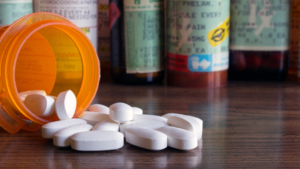Young People are at High Risk for Opioid-Related Overdose
Stacey J. Drubner, JD, LICSW, MPH

EAP Ask the Expert: Scott Weiner, MD, MPH – Chief, Department of Emergency Medicine Division of Health Policy and Public Health & Director – The Brigham Comprehensive Opioid Response and Education Program – Brigham & Women’s Hospital
Which one of the people pictured above could have an opioid use disorder (OUD) or experience an overdose? If you answered any of them, you are correct.
Most of us have some familiarity with the Opioid Overdose Epidemic. The problem started when opioids were prescribed too generously for pain, and there was not a clear understanding of the risk for dependence and addiction. Although providers are being more considerate with prescribing, there are new factors which now make it hard to counteract the incidence of overdoses. This is largely due to the introduction of synthetic opioids, such as fentanyl into the illicit drug supply. According to The Commonwealth Fund, as of June 2021, synthetic opioids were involved in 87% of opioid-related deaths and 65% of all drug overdose deaths.
Sometimes, statistics don’t make us feel connected to a problem. However, given the prevalence of the Opioid Overdose Epidemic, chances are high that all (either as health care providers, family members, or friends), will be impacted in one way or another.
- According to the National Safety Council Survey, 75% of employers report that opioid use has impacted their workplace
- The nationwide death toll from opioids during 2021 was an estimated 80,000, representing a 15% increase from 2020
- Overdose deaths in the Commonwealth of Massachusetts have remained steady at about 2000 per year. This might be due to fentanyl’s availability in Massachusetts (and the Northeast), earlier than in some other parts of the United States. This prompted measures to mitigate deaths. However, 2000+ a year is still a devastating number
Young People have a High Risk for Overdose Deaths
One population of significant concern, and the focus of this feature, is adolescents and young adults.
- Bloomberg reported on provisional data from the CDC, indicating that overdose deaths linked to synthetic opioids have tripled among teenagers and increased five times among black teens in the past two years. The rise in deaths of black teens is attributed largely to the presence of fentanyl in drugs that are not perceived to be opioids
- From Health Affairs – Two out of three adults treated for opioid use disorders first used opioids when they were younger than age 25
- For the period of January-September 2021, The Commonwealth of Massachusetts reported 325 deaths attributed to opioid overdoses in individuals aged 15-34
Spotlight: Scott Weiner MD, MPH
Chief, Department of Emergency Medicine Division of Health Policy and Public Health & Director - The Brigham Comprehensive Opioid Response and Education Program - Brigham & Women’s Hospital

Dr. Weiner lends his expertise to help us understand the problem of OUD and overdoses in adolescents and young adults.
Why are Adolescents and Young Adults so at Risk?
Scott explains that there is a “perfect storm” of factors that make this population susceptible.
“Teens will be Teens” and have:
- A desire to test their independence
- Peer pressure
- Responsiveness to “try this-you will have a good time”
- Developing brains that are more tolerant of risky behaviors
- The lack of insight to realize the long or short-term negative effects, despite the reality of legitimate danger
- The belief that they are indestructible. It’s unfathomable that something bad would happen to them. The concept of harm impacting them seems distant and abstract
The impact of the drug supply chain and access issues
There are still examples of “traditional overdoses” from legitimately prescribed drugs found inside the home. However, as discussed above, most overdoses now involve illicit drugs sourced in the community. In part, this is due to access issues – doctors are not typically prescribing 30-60 oxycodone pills for a routine surgery anymore and people are more aware of the need to secure or dispose of unused medications. The Pandemic disrupted the heroin supply chain, opening the door for the need for the synthetic option.
Prescription opioids from the home do lead to overdose and death for some people who develop a tolerance or an addiction, but not in the manner that is associated with illicit “street drugs.” Many “opioid naïve” kids are going right to illicit drugs, which are more potent and likely to lead to an overdose.
The heavy reliance on on street drugs, such as those containing synthetic fentanyl, by adolescent and young adults are a major factor behind their increased risk
Opioids are easily accessible in the community, including at school. Even kids who don’t use drugs know who is selling them and where to get them. To highlight how important community access is, the Monitoring the Future Survey showed a big drop in students reporting illicit drug use during the earlier part of the Pandemic. This is probably attributable to the lack of access when schools were closed, and contacts diminished.
Scott explains that despite all the positive gains in fighting misuse and overdose with traditional opioids, the illicit drugs are “cutting us off at every pass”. Why?
- Drugs from dealers are not uniform or pharmaceutical grade; each administration has a different chemical composition, dose, and concentration
- The effect is unpredictable and variable
- These drug are so potent that first time users are dying and sometimes even Narcan (discussed in detail below) is not effective
- Scott points out that teens are more comfortable with pills, and unfortunately the street drugs (which press fentanyl into pill form) look remarkably similar to pharmaceutical produced pills, such as oxycodone or valium. This DEA Advisory illustrates the similar nature of these pills. Kids may mistakenly assume that a pill that looks like a prescription pill is somehow safer than injectables
- “Opioid naïve” teens and young adults are not only unaware that drugs labeled as opioids have fentanyl, but also that many (cocaine, benzodiazepines, methamphetamine), that are not believed to be opioids do as well
Scott offers the following: “If you are consciously using an opioid sourced from the community (dealer), it’s most likely that you are using fentanyl.”
How can Parents try to Prevent a Problem with Opioids in the First Place?
Establish an open dialogue about the serious dangers of opioids
Conversations can be difficult but it’s important for kids to understand that one use of an opioid or an unintended opioid could kill them. While this EAP News Feature was in process, a 22-year-old from the North Shore of Massachusetts died after taking one street-sourced Percocet at a party and 3 teens in Los Angeles overdosed from fentanyl-laced ecstasy pills, sourced on the Internet.
Scott emphasizes that the best strategy is to have regular dialogue with your kids. The “dinner table” is the best antidote.
- Allow kids to speak freely, without judgment
- Be realistic and open-minded
- Keep the door open for future conversations
- Cover the big picture and all components, not just school
- Ask about what gap drugs might be filling, and how they might swap out drugs for another activity, hobby, exercise, or community service
Address the issue of opioids before medical procedures or treatment for injuries
Of course, providers are experts in their respective fields, but parents know their children best. You can be involved in decisions about what medications your child is prescribed and it’s always a good idea to be an informed participant in your child’s care.
Educate yourself about the side effects of opioids
Opioids work on the receptor in the brain that mediates pain but are also responsible for a whole host of other things.
- The most serious and dangerous side effect is respiratory depression. This is the reason people get into trouble with overdoses
- Impacts on the GI tract are very common and can lead to abdominal pain and constipation
- There are impacts on the endocrine system
- Longer term effects are dependence and addiction. Individuals who use a drug repetitively build up a tolerance and need to use higher doses to get the same effect (euphoria; masking of pain) and prevent withdrawal
Consider pain management alternatives, which often work better and are less susceptible to tolerance or substance use disorders
 Despite all we have learned, there are still examples of unnecessary use of or over-prescribing of opioids. Tolerance to opioids can happen very quickly (in just 2-3 days) for some individuals. In recent times, kids were prescribed 30-60 oxycodone pills for wisdom teeth removal or orthopedic surgeries.
Despite all we have learned, there are still examples of unnecessary use of or over-prescribing of opioids. Tolerance to opioids can happen very quickly (in just 2-3 days) for some individuals. In recent times, kids were prescribed 30-60 oxycodone pills for wisdom teeth removal or orthopedic surgeries.
Acute pain from many procedures lasts about 2-3 days and can often be treated successfully with a combination of acetaminophen (Tylenol) or ibuprofen (Advil or Motrin), for those without contraindications. Opioids do not need to be the first line of defense. Scott adds that opioids mask but do not treat pain. They provide no anti-inflammatory effect.
With a few specific exceptions, there should not be long-term use of opioids. Studies show the benefits of chronic opioid therapy are inferior to the risks, particularly when the goal is to improve someone’s function. Non-opioids often have more favorable outcomes and less side effects.
Be an advocate with providers
It’s totally acceptable and important to discuss plans for pain management with your child’s prescriber. Review:
- The amount of pain to expect and thresholds for use of medication
- If opioids are truly necessary
- The strongest and best pain treatment for these circumstances and potential side-effects
- The number of pills being prescribed
- How long the medications are typically needed
- The process for follow-up if pain persists longer than expected. Make sure there are no surgical complications and ask for next line alternatives, such as lidocaine patches, physical therapy, or acupuncture
- How to prevent unwanted side effects, such as dependence, gastro complications
Monitor and manage medication use
- Supervise the use of opioids -how many are taken and when
- Help your child taper as soon as possible
- Make sure your child knows not to share their medicine with anyone else
- Secure or dispose of drugs as soon as they are no longer needed
Student athletes
Student athletes are at particular risk for opioid misuse because they often deal with pain from injuries or surgeries. Goals of getting back on the field, court or ice may influence them to seek interventions, such as opioids that they believe will be a quick fix. It’s important to educate student athletes about the actual benefits and pros and cons of treatment options. This video from the Brigham might be a helpful tool. Advocacy and collaboration with treatment providers is important. This is in part because athletes are compliant with the advice of medical professionals, who often control whether or not they can return to playing sports after an injury.
How to Help when you think a Teen or Young Adult might be Using Opioids
As a parent, you can’t predict or prepare for every specific potential scenario, but it’s helpful to understand some baseline information and options for assistance before you are faced with a crisis.
Understand the potential warning signs of an opioid problem
Scott cautions that the signs of opioid misuse are similar to the markers of other issues, such as depression, anxiety, or social issues at school. Of course, some behaviors are just a function of the “normal” teen or young adult life phase. Here are things to look out for and evaluate:
- Being more withdrawn and non-communicative
- Lack of interest in regular activities
- Dropping grades
- Deviations from what is typical for your teen. Parents know their child and are in the best position to notice a concerning change
If your child was prescribed drugs for a legitimate reason, the risk of traditional misuse is still a possibility. Here are some warning signs for this scenario.
Interventions
When it pertains to adolescents and young adults, some aspects of intervention can be controversial or taboo. It’s difficult to think about people so young using such dangerous drugs (particularly when fentanyl is involved). The number one goal is to prevent use and misuse of drugs in the first place. Unfortunately, statistics show an existing, growing and concerning opioid overdose problem with adolescents and young adults. In the interest of harm reduction, we present some resources for assistance and prevention of loss of life, with the caveat that there are different societal or provider perspectives and state laws regarding some of these interventions.
Naloxone
Naloxone, also known as Narcan, is an opioid reversal drug. We are starting to see this antidote stored in public places and there is an effort to make sure it’s available in the same settings where we have other life-saving tools, such as defibrillators. Scott cautions people to understand that Narcan cannot be administered by an overdosing person. It does not work like an Epi-pen. The safest option is to make sure someone is available to administer this drug if your child is on high dose prescription opioids or is using illicit drugs that might contain fentanyl.
Fentanyl strips
As we have discussed throughout this article, almost all opioids and many non-opioids, sourced from the street, are likely to contain fentanyl, which is extremely potent and unpredictable. Fentanyl has been entrenched in the New England supply chain for at least 5 years and has spread across the country during the Pandemic. Fentanyl strips offer a way to detect fentanyl before using a drug that someone doesn’t expect to contain it.
Suboxone
Suboxone is a combination medication containing Buprenorphine and Naloxone, which is used to treat opioid use disorders. Scott explains that Suboxone is not an even swap for other opioids because it works in a different way pharmacologically. Regardless, there is significant stigma around the perception of the need to be on a maintenance drug or being viewed as a person with a substance use disorder. Some Narcotics Anonymous (NA) groups do not allow members who are on Suboxone. Some parents and providers are reluctant to start young people on the Suboxone path. As a society, we accept the concept of insulin as an on-going treatment for diabetes, even with some instances (of type 2 diabetes), related to lifestyle choices. Drug misuse can also stem from a medical condition, but many tend to label individuals who have a substance use disorder as having personal culpability and individual responsibility for resolution.
How to get help
- Reach out to a professional or someone who knows how to navigate the system or can provide guidance on getting treatment in physical and psychological avenues of care
- Start with preventing loss of life (with things such as safer drug use) and proceed from there
- Get assistance to safely stop or titrate opioids
- Evaluate what is behind the drug use and determine how to identify and implement alternative coping strategies
- Don’t let stigma prevent your family from getting help
- Be realistic about the process of recovery
- Hold onto the belief that healing and recovery are attainable. Scott has the pleasure of following up with patients who report they are off opioids and feel as though they are “lifted out of a cloud”
- Here are some tips for broaching the subject of getting help with your child
How can our System Contribute to Helping with the Opioid Epidemic?
Scott suggests that one of the biggest barriers to addressing this epidemic and providing help relates to the stigma associated with opioid misuse. Here are some ideas for minimizing stigma.
- Put a spotlight on acknowledging the existence of this problem
- Be honest about the prevalence of and non-discriminatory reach of opioids
- Normalize by expanding the parts of the system where screening, dialogue and treatment take place
- Build easier and more seamless avenues for clinicians to get education and provide or refer for help
- Encourage continued consideration of alternate methods to treat pain
Help from the EAP
The Mass General Brigham EAP offers free and confidential services for employees and immediate household family members. EAP records are separate from medical and HR records. Contact the EAP at 866-724-4327 or request an appointment via our online form for confidential assistance.







